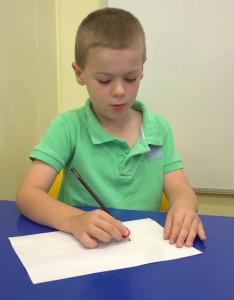 Children’s sensory systems can often be overwhelmed after a busy, noisy day at school. Before children settle in to do their homework they often benefit from preparing their sensory system so they can settle and concentrate on the new task at hand.
Children’s sensory systems can often be overwhelmed after a busy, noisy day at school. Before children settle in to do their homework they often benefit from preparing their sensory system so they can settle and concentrate on the new task at hand.
Below are some strategies to help prepare children’s sensory systems for a more successful homework effort.
1. Take a break before you begin. Give your child at least 30 minutes of free sensory play when they arrive home from school. This break should NOT have any screen time in it (TV, iPads, games etc.) Perhaps screen time can be used as a reward after homework if it is to be included in your child’s day.
2. Offer sensory activities during the 30 minute break. Activities offered should be primarily ‘vestibular’ and ‘proprioceptive’.
Proprioception is the most powerful form of sensory input. It can reduce over-responsivity , helping kids to find the just right level of alertness and decrease anxiety.
Some activities include:
- Having a gym ball rolled over their back and arms while lying on the floor to calm them down, slowly rolling up and back. This could be done with soothing music.
- Rolling along the floor on a scooter board while lying on their stomach to work the child’s back, stomach and arm muscles. Encourage the child to use their two hands symmetrically or pull themselves along on a rope.
- Spending time hanging from monkey bars and climbing on playground equipment to give their wrists and knees more proprioception.
- Log rolling along the floor for whole body proprioception.
- Bouncing on a hopping ball.
- Helping to lift and carry heavy things e.g. bringing in washing from the clothes line, returning a bag of books to the library, or carrying, pushing or pulling along a box of toys.
- Moving in different animal positions e.g. rabbit, frog, snake, bear, crab or duck.
- Play dough, theraputty, pegs, squeeze bottles and sponges provide proprioceptive input to the fingers and wrist joints.
- Have a game of tug-of-war with a rope or gym ball.
- Create an obstacle course with opportunities for jumping, hopping, crawling, climbing and balancing.
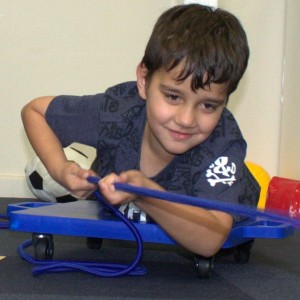 Vestibular actvities are about stimulating your child's sense of balance and are also calming. Below are a number of activities that you can complete with your children to increase the amount of vestibular input they are receiving:
Vestibular actvities are about stimulating your child's sense of balance and are also calming. Below are a number of activities that you can complete with your children to increase the amount of vestibular input they are receiving:
- Get your child to hang upside down on monkey bars
- Balance on a wobble board while throwing and catching a beanbag or ball.
- Encourage your child to lie over a gym ball while they push and pulls against your hands. Rock your child on the gym ball while holding on to their legs whilst they lay on their tummy or back.
- Pretend to be a bird by running on tiptoes, slowing down, then landing on a perch
- Roll your child up in a blanket while they are lying on the floor, then unroll them.
- Do some trampoline exercises, such as jumping, kneeling, sitting, turning.
- Encourage your child to do some skipping with hoops or ropes.
- Get your child to jump over a “snake” (wiggling rope).
- Encourage your child to use playground equipment, such as swings and slides.
- Encourage your child to do some bicycle riding or scooter riding.
- Have your child swing themselves by touching the ground with their hands, pushing off from a wall, pulling on a rope, or pretending to row a boat using a broom handle
- Encourage your child to swing on a swing. Whilst swinging the child can play target games such as quoits, beanbag toss, or throwing and catching a ball.
- Get your child to sit with their feet in the middle of a tyre and bound around it.
- Get your child to sit on a scooter-board whilst you spin them around while they are holding on to a hoop. You could also get your child to spin themselves around on the scooter-board.
3. Include sucking and blowing games before homework. Your child may also benefit from sucking games and blowing games as these can be calming and help children prepare for focused work. This could include:
- picking up ping pong balls by sucking through a straw
- blowing bubbles with a straw in a cup of water and dish detergent
- blowing cotton balls with a straw
- blowing up balloons and letting them go
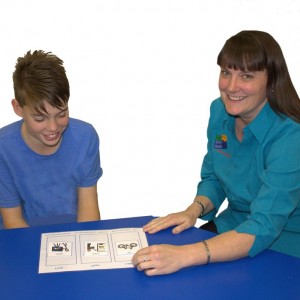 4. Break the task down into smaller chunks and use visuals. Use a visual schedule to show what needs to be done in what order. Show where the breaks are and give your child a choice of activities to do in the breaks. These needs to be quick simple movement based activities such as those in the lists above. For younger children a "first then" schedule may work better with one task and then a break activity or short reward for each task. For more information on using visuals click here. Offer a reward for completing all the tasks. Your child's special interests can be a big motivator.
4. Break the task down into smaller chunks and use visuals. Use a visual schedule to show what needs to be done in what order. Show where the breaks are and give your child a choice of activities to do in the breaks. These needs to be quick simple movement based activities such as those in the lists above. For younger children a "first then" schedule may work better with one task and then a break activity or short reward for each task. For more information on using visuals click here. Offer a reward for completing all the tasks. Your child's special interests can be a big motivator.
5. Offer a crunchy or chewy snack. Offer a crunchy or chewy snack during homework time. Or you could offer a drink where they need to use some resistive sucking through a straw. A drink such as a smoothie, or even sucking a yoghurt or pudding through a straw will provide some resistance.
6. Chewing during homework. Your child may benefit from some chewing while doing their homework, either a chewing gum if they are old enough, or another oral sensory tool designed for chewing, such as ‘chewellery’.
7. Do homework in a quiet area. Provide a quiet place that is free from distraction. Kitchens or living rooms are often too noisy and busy and children are easily distracted.
8. Think about seating. Sometimes your child may work better sitting in a different position. For example, some children will achieve more if they are allowed to sit in a ‘squish box’ or another sensory retreat. They could use a clipboard for the surface. Ensure they have appropriate lighting to see their work.
9. Use a vertical surface. Using a vertical surface such as an easel or even taping the work to a flat surface on the wall may assist. Your child could use a chalkboard or dry erase board for working out math problems etc.
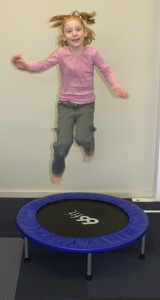 10. Use a swing. Use either an indoor or outdoor swing or trampoline for assisting children to remember things they need to learn with lots of repetition such as spelling, times tables, or counting.
10. Use a swing. Use either an indoor or outdoor swing or trampoline for assisting children to remember things they need to learn with lots of repetition such as spelling, times tables, or counting.
11. Use an activity ball chair. Swap out the standard chair for a ball chair. Therapy balls are available at quite a low cost from most sports or department stores.
12. Lay on your stomach. Some children will work better if they are able to lay on their stomach and use their elbows for support. This works particularly well for reading.
13. No TV. DO NOT allow the TV to be running in the background. It is a distraction and does not assist your child in developing the skills need to fully concentrate on the task at hand. Children will tell you they can do their homework properly with the TV on but this is not the case.
14. Use a fidget toy. Provide your child with a fidget toy of their liking. It should be something they can fidget with using their non-dominant hand while they write with their dominant hand. If they start ‘playing’ with the toy rather than fidgeting with it they should be reminded that the fidget is not something that should be a distraction. Their attention must be on the task at hand rather than the fidget or it’s no longer functioning like a fidget.
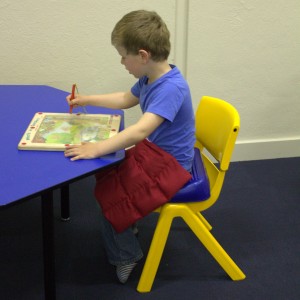 15. Use a weighted product such as a weighted lap blanket. These often help kids stay calm and focused for seated activities.Here are more ideas on using weighted products.
15. Use a weighted product such as a weighted lap blanket. These often help kids stay calm and focused for seated activities.Here are more ideas on using weighted products.
These strategies can of course be applied to other situations, such as in the classroom. Talk to your child’s OT for help in choosing the best sensory strategies for your child.
Looking for support for your child? Talking Matters has speech pathologists and a team of occupational therapists who can help with children's sensory challenges. We also have a psychologist to help with social, emotional and behavioural challenges. Find out more about how Talking Matters can help your child and support your family.
Talking Matters now has an ASD consultant who can help develop individual supports and strategies for children to use at home and at school. Find out more about this service.
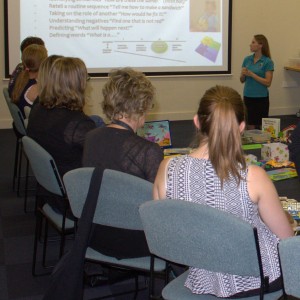 Looking to learn more about ASD? We have a number of workshops planned for teachers, SSOs and child care workers to support children with ASD.
Looking to learn more about ASD? We have a number of workshops planned for teachers, SSOs and child care workers to support children with ASD.
Talking Matters provides assessment, diagnosis, therapy and support for children on the autism spectrum and their families. We are providers under NDIA and we are also happy to accept medicare plans. To find out more about our services and our team visit our website. To connect with our community of families, therapists and educators join us on Facebook, Twitter and Pinterest.
We hope you find these strategies helpful for the person in your life with ASD!
Related Blog Posts
If you liked this post you may also like:
Developing recounts
20 tips for social skills
Playdough Faces
Talk with me...about friends and feelings.



